Hospitality Management: Speed, Throughput, Efficiency, Productivity
VerifiedAdded on 2022/09/01
|9
|2108
|25
Report
AI Summary
This report delves into the crucial performance objectives of speed, throughput rate, efficiency, and productivity within the hospitality industry, using McDonald's as a case study. It explains how speed directly impacts customer satisfaction, and how throughput rate, efficiency, and productivity are interconnected and essential for operational success. The report examines the importance of operational efficiency in reducing costs and waste, and increasing profits. Furthermore, the impact of new technologies on quality, cost, flexibility, and dependability is evaluated, highlighting how technology can improve service, reduce costs, and increase customer satisfaction. The report concludes by emphasizing the significance of these performance objectives for success in the competitive hospitality market.
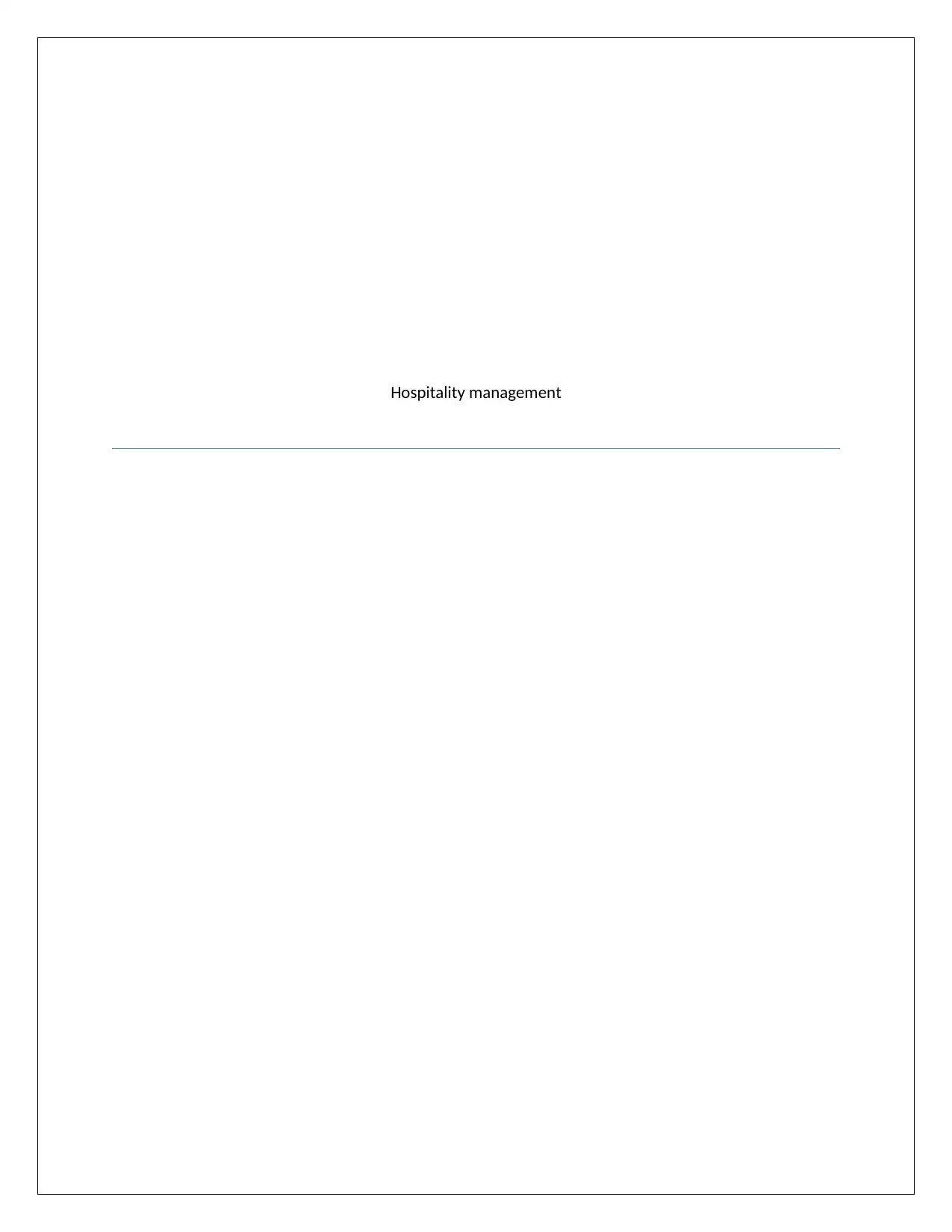
Hospitality management
Paraphrase This Document
Need a fresh take? Get an instant paraphrase of this document with our AI Paraphraser
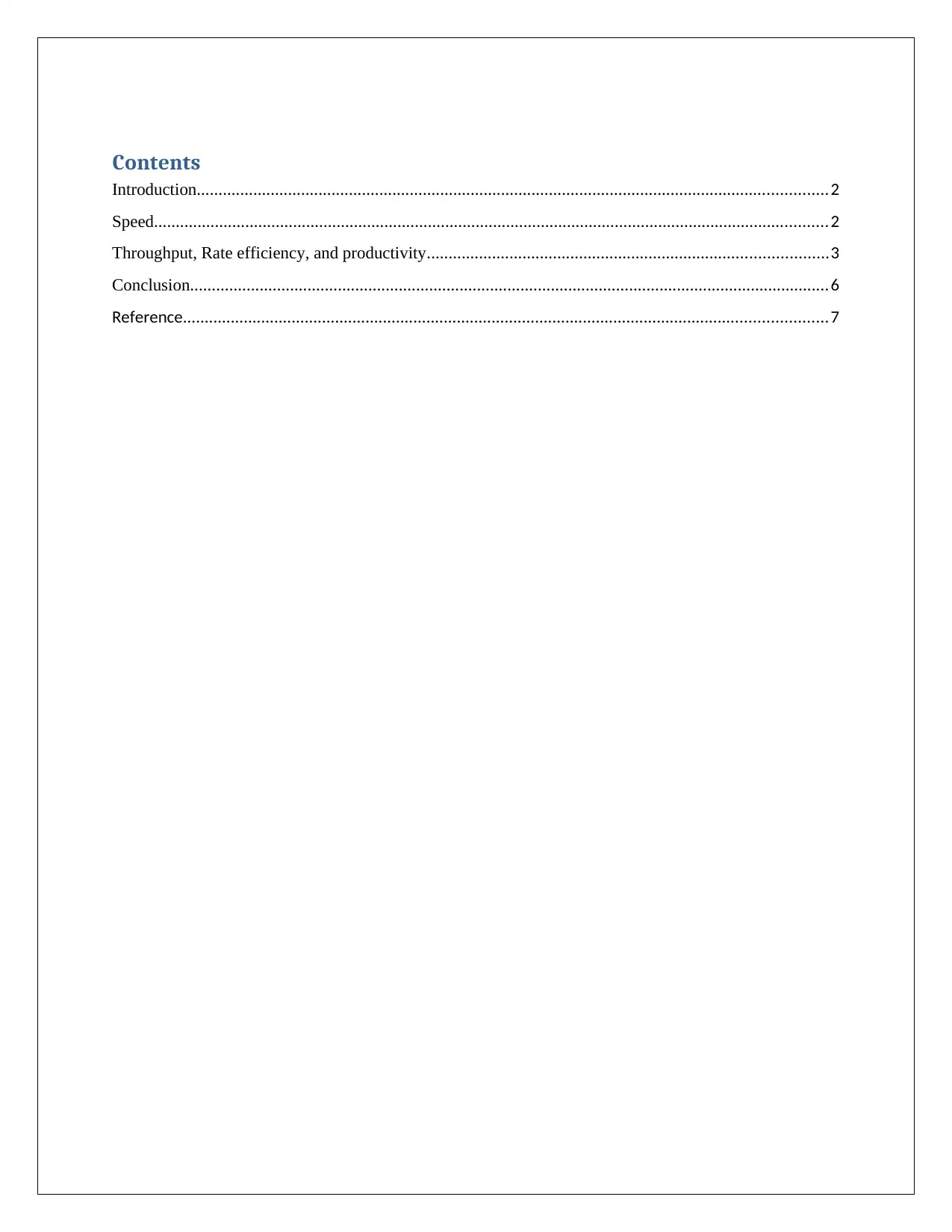
Contents
Introduction.................................................................................................................................................2
Speed...........................................................................................................................................................2
Throughput, Rate efficiency, and productivity............................................................................................3
Conclusion...................................................................................................................................................6
Reference....................................................................................................................................................7
Introduction.................................................................................................................................................2
Speed...........................................................................................................................................................2
Throughput, Rate efficiency, and productivity............................................................................................3
Conclusion...................................................................................................................................................6
Reference....................................................................................................................................................7
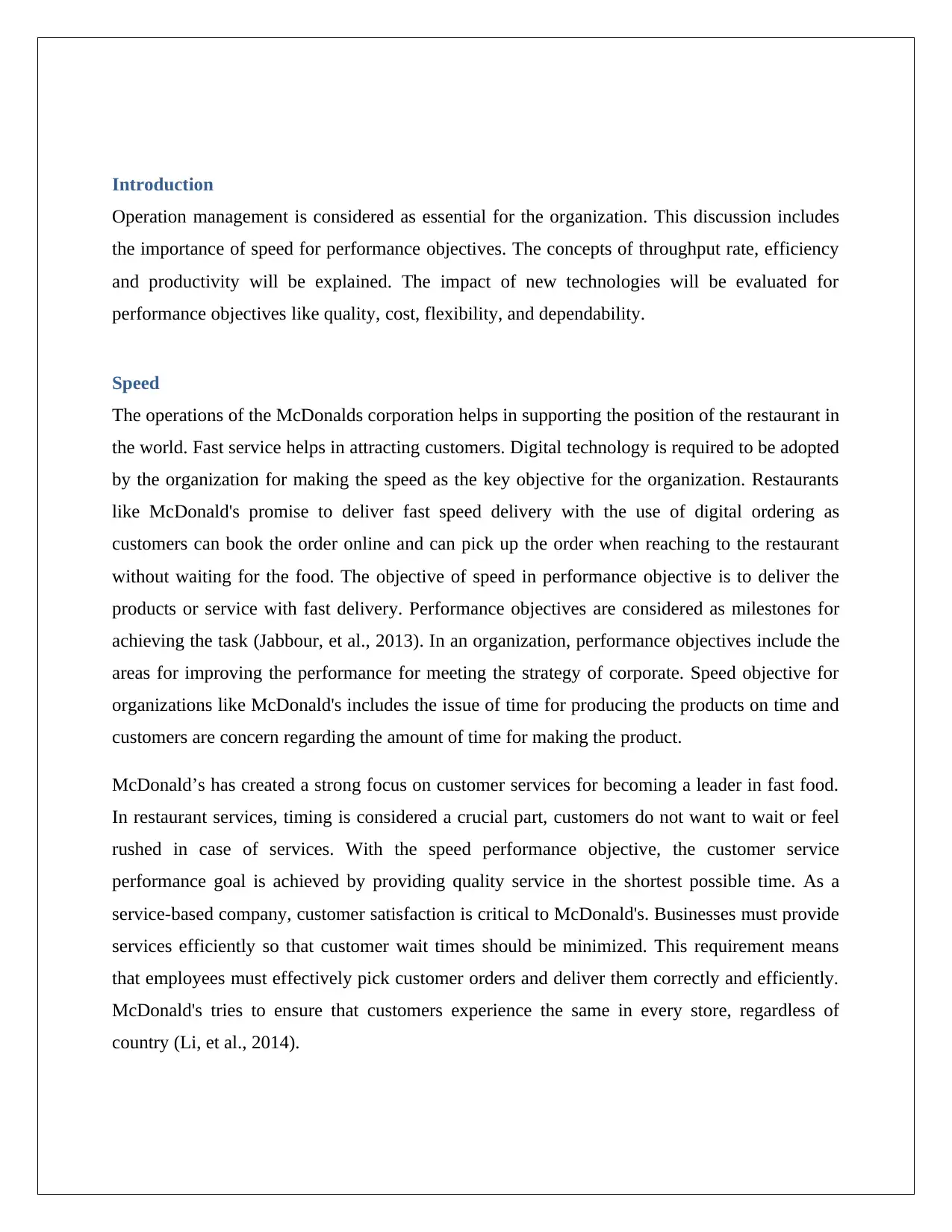
Introduction
Operation management is considered as essential for the organization. This discussion includes
the importance of speed for performance objectives. The concepts of throughput rate, efficiency
and productivity will be explained. The impact of new technologies will be evaluated for
performance objectives like quality, cost, flexibility, and dependability.
Speed
The operations of the McDonalds corporation helps in supporting the position of the restaurant in
the world. Fast service helps in attracting customers. Digital technology is required to be adopted
by the organization for making the speed as the key objective for the organization. Restaurants
like McDonald's promise to deliver fast speed delivery with the use of digital ordering as
customers can book the order online and can pick up the order when reaching to the restaurant
without waiting for the food. The objective of speed in performance objective is to deliver the
products or service with fast delivery. Performance objectives are considered as milestones for
achieving the task (Jabbour, et al., 2013). In an organization, performance objectives include the
areas for improving the performance for meeting the strategy of corporate. Speed objective for
organizations like McDonald's includes the issue of time for producing the products on time and
customers are concern regarding the amount of time for making the product.
McDonald’s has created a strong focus on customer services for becoming a leader in fast food.
In restaurant services, timing is considered a crucial part, customers do not want to wait or feel
rushed in case of services. With the speed performance objective, the customer service
performance goal is achieved by providing quality service in the shortest possible time. As a
service-based company, customer satisfaction is critical to McDonald's. Businesses must provide
services efficiently so that customer wait times should be minimized. This requirement means
that employees must effectively pick customer orders and deliver them correctly and efficiently.
McDonald's tries to ensure that customers experience the same in every store, regardless of
country (Li, et al., 2014).
Operation management is considered as essential for the organization. This discussion includes
the importance of speed for performance objectives. The concepts of throughput rate, efficiency
and productivity will be explained. The impact of new technologies will be evaluated for
performance objectives like quality, cost, flexibility, and dependability.
Speed
The operations of the McDonalds corporation helps in supporting the position of the restaurant in
the world. Fast service helps in attracting customers. Digital technology is required to be adopted
by the organization for making the speed as the key objective for the organization. Restaurants
like McDonald's promise to deliver fast speed delivery with the use of digital ordering as
customers can book the order online and can pick up the order when reaching to the restaurant
without waiting for the food. The objective of speed in performance objective is to deliver the
products or service with fast delivery. Performance objectives are considered as milestones for
achieving the task (Jabbour, et al., 2013). In an organization, performance objectives include the
areas for improving the performance for meeting the strategy of corporate. Speed objective for
organizations like McDonald's includes the issue of time for producing the products on time and
customers are concern regarding the amount of time for making the product.
McDonald’s has created a strong focus on customer services for becoming a leader in fast food.
In restaurant services, timing is considered a crucial part, customers do not want to wait or feel
rushed in case of services. With the speed performance objective, the customer service
performance goal is achieved by providing quality service in the shortest possible time. As a
service-based company, customer satisfaction is critical to McDonald's. Businesses must provide
services efficiently so that customer wait times should be minimized. This requirement means
that employees must effectively pick customer orders and deliver them correctly and efficiently.
McDonald's tries to ensure that customers experience the same in every store, regardless of
country (Li, et al., 2014).
⊘ This is a preview!⊘
Do you want full access?
Subscribe today to unlock all pages.

Trusted by 1+ million students worldwide
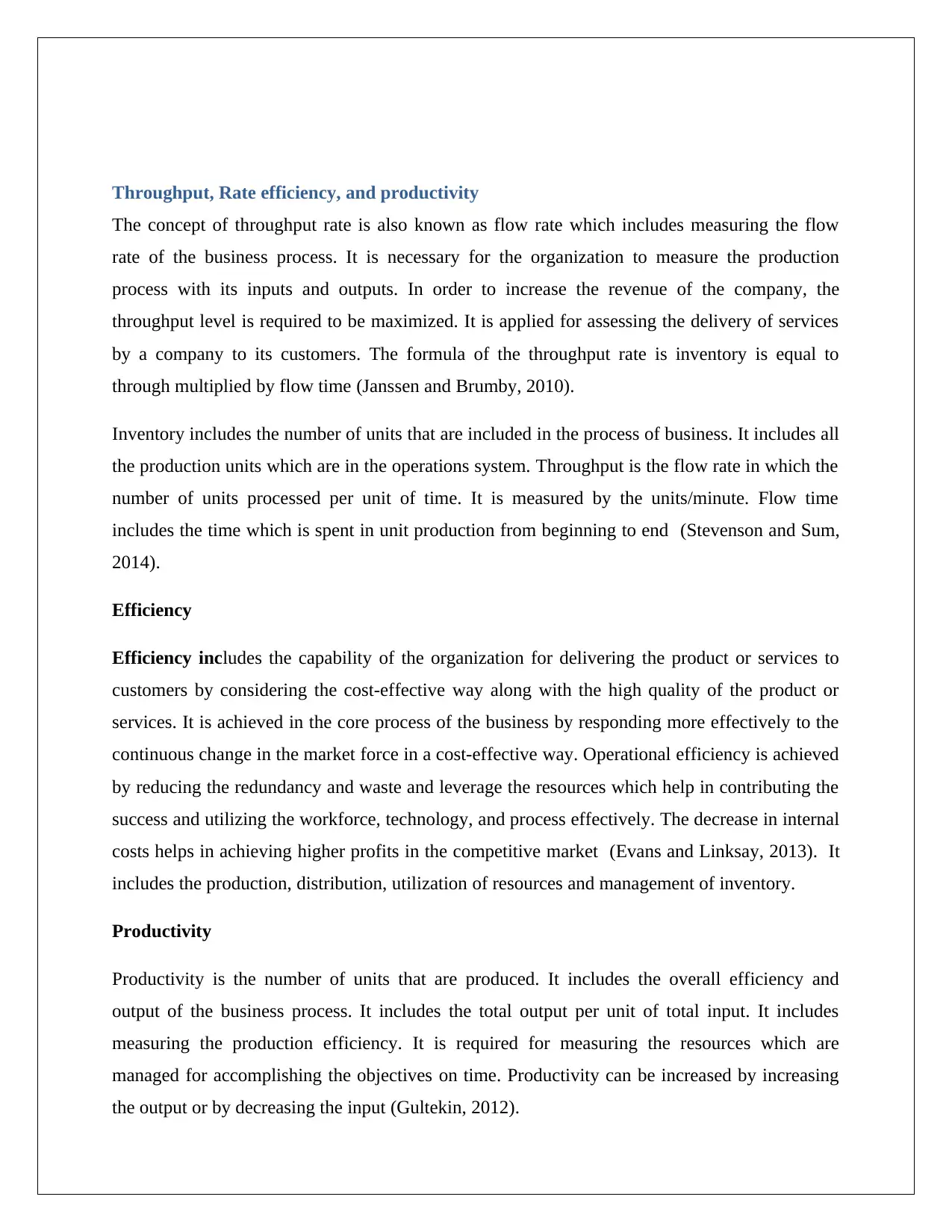
Throughput, Rate efficiency, and productivity
The concept of throughput rate is also known as flow rate which includes measuring the flow
rate of the business process. It is necessary for the organization to measure the production
process with its inputs and outputs. In order to increase the revenue of the company, the
throughput level is required to be maximized. It is applied for assessing the delivery of services
by a company to its customers. The formula of the throughput rate is inventory is equal to
through multiplied by flow time (Janssen and Brumby, 2010).
Inventory includes the number of units that are included in the process of business. It includes all
the production units which are in the operations system. Throughput is the flow rate in which the
number of units processed per unit of time. It is measured by the units/minute. Flow time
includes the time which is spent in unit production from beginning to end (Stevenson and Sum,
2014).
Efficiency
Efficiency includes the capability of the organization for delivering the product or services to
customers by considering the cost-effective way along with the high quality of the product or
services. It is achieved in the core process of the business by responding more effectively to the
continuous change in the market force in a cost-effective way. Operational efficiency is achieved
by reducing the redundancy and waste and leverage the resources which help in contributing the
success and utilizing the workforce, technology, and process effectively. The decrease in internal
costs helps in achieving higher profits in the competitive market (Evans and Linksay, 2013). It
includes the production, distribution, utilization of resources and management of inventory.
Productivity
Productivity is the number of units that are produced. It includes the overall efficiency and
output of the business process. It includes the total output per unit of total input. It includes
measuring the production efficiency. It is required for measuring the resources which are
managed for accomplishing the objectives on time. Productivity can be increased by increasing
the output or by decreasing the input (Gultekin, 2012).
The concept of throughput rate is also known as flow rate which includes measuring the flow
rate of the business process. It is necessary for the organization to measure the production
process with its inputs and outputs. In order to increase the revenue of the company, the
throughput level is required to be maximized. It is applied for assessing the delivery of services
by a company to its customers. The formula of the throughput rate is inventory is equal to
through multiplied by flow time (Janssen and Brumby, 2010).
Inventory includes the number of units that are included in the process of business. It includes all
the production units which are in the operations system. Throughput is the flow rate in which the
number of units processed per unit of time. It is measured by the units/minute. Flow time
includes the time which is spent in unit production from beginning to end (Stevenson and Sum,
2014).
Efficiency
Efficiency includes the capability of the organization for delivering the product or services to
customers by considering the cost-effective way along with the high quality of the product or
services. It is achieved in the core process of the business by responding more effectively to the
continuous change in the market force in a cost-effective way. Operational efficiency is achieved
by reducing the redundancy and waste and leverage the resources which help in contributing the
success and utilizing the workforce, technology, and process effectively. The decrease in internal
costs helps in achieving higher profits in the competitive market (Evans and Linksay, 2013). It
includes the production, distribution, utilization of resources and management of inventory.
Productivity
Productivity is the number of units that are produced. It includes the overall efficiency and
output of the business process. It includes the total output per unit of total input. It includes
measuring the production efficiency. It is required for measuring the resources which are
managed for accomplishing the objectives on time. Productivity can be increased by increasing
the output or by decreasing the input (Gultekin, 2012).
Paraphrase This Document
Need a fresh take? Get an instant paraphrase of this document with our AI Paraphraser
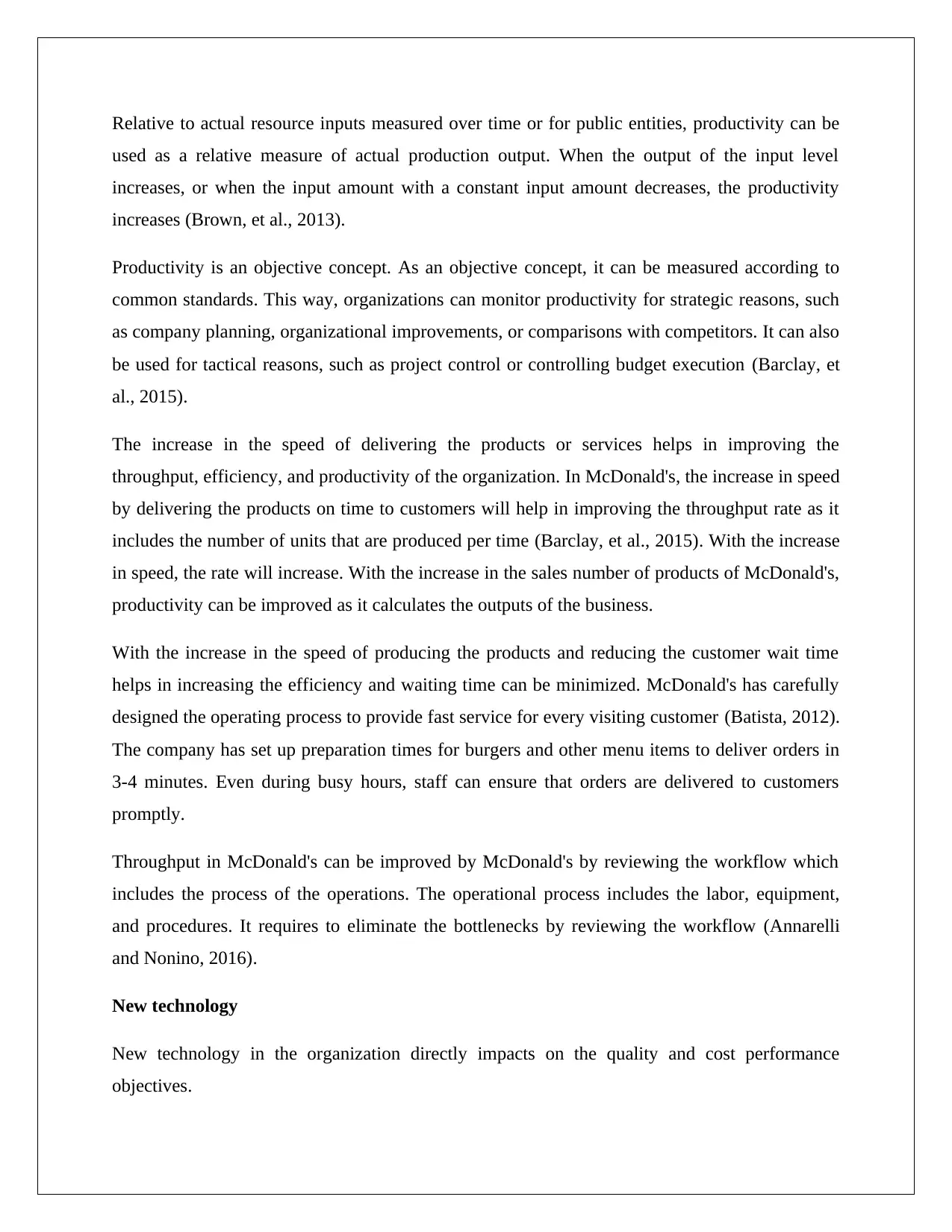
Relative to actual resource inputs measured over time or for public entities, productivity can be
used as a relative measure of actual production output. When the output of the input level
increases, or when the input amount with a constant input amount decreases, the productivity
increases (Brown, et al., 2013).
Productivity is an objective concept. As an objective concept, it can be measured according to
common standards. This way, organizations can monitor productivity for strategic reasons, such
as company planning, organizational improvements, or comparisons with competitors. It can also
be used for tactical reasons, such as project control or controlling budget execution (Barclay, et
al., 2015).
The increase in the speed of delivering the products or services helps in improving the
throughput, efficiency, and productivity of the organization. In McDonald's, the increase in speed
by delivering the products on time to customers will help in improving the throughput rate as it
includes the number of units that are produced per time (Barclay, et al., 2015). With the increase
in speed, the rate will increase. With the increase in the sales number of products of McDonald's,
productivity can be improved as it calculates the outputs of the business.
With the increase in the speed of producing the products and reducing the customer wait time
helps in increasing the efficiency and waiting time can be minimized. McDonald's has carefully
designed the operating process to provide fast service for every visiting customer (Batista, 2012).
The company has set up preparation times for burgers and other menu items to deliver orders in
3-4 minutes. Even during busy hours, staff can ensure that orders are delivered to customers
promptly.
Throughput in McDonald's can be improved by McDonald's by reviewing the workflow which
includes the process of the operations. The operational process includes the labor, equipment,
and procedures. It requires to eliminate the bottlenecks by reviewing the workflow (Annarelli
and Nonino, 2016).
New technology
New technology in the organization directly impacts on the quality and cost performance
objectives.
used as a relative measure of actual production output. When the output of the input level
increases, or when the input amount with a constant input amount decreases, the productivity
increases (Brown, et al., 2013).
Productivity is an objective concept. As an objective concept, it can be measured according to
common standards. This way, organizations can monitor productivity for strategic reasons, such
as company planning, organizational improvements, or comparisons with competitors. It can also
be used for tactical reasons, such as project control or controlling budget execution (Barclay, et
al., 2015).
The increase in the speed of delivering the products or services helps in improving the
throughput, efficiency, and productivity of the organization. In McDonald's, the increase in speed
by delivering the products on time to customers will help in improving the throughput rate as it
includes the number of units that are produced per time (Barclay, et al., 2015). With the increase
in speed, the rate will increase. With the increase in the sales number of products of McDonald's,
productivity can be improved as it calculates the outputs of the business.
With the increase in the speed of producing the products and reducing the customer wait time
helps in increasing the efficiency and waiting time can be minimized. McDonald's has carefully
designed the operating process to provide fast service for every visiting customer (Batista, 2012).
The company has set up preparation times for burgers and other menu items to deliver orders in
3-4 minutes. Even during busy hours, staff can ensure that orders are delivered to customers
promptly.
Throughput in McDonald's can be improved by McDonald's by reviewing the workflow which
includes the process of the operations. The operational process includes the labor, equipment,
and procedures. It requires to eliminate the bottlenecks by reviewing the workflow (Annarelli
and Nonino, 2016).
New technology
New technology in the organization directly impacts on the quality and cost performance
objectives.
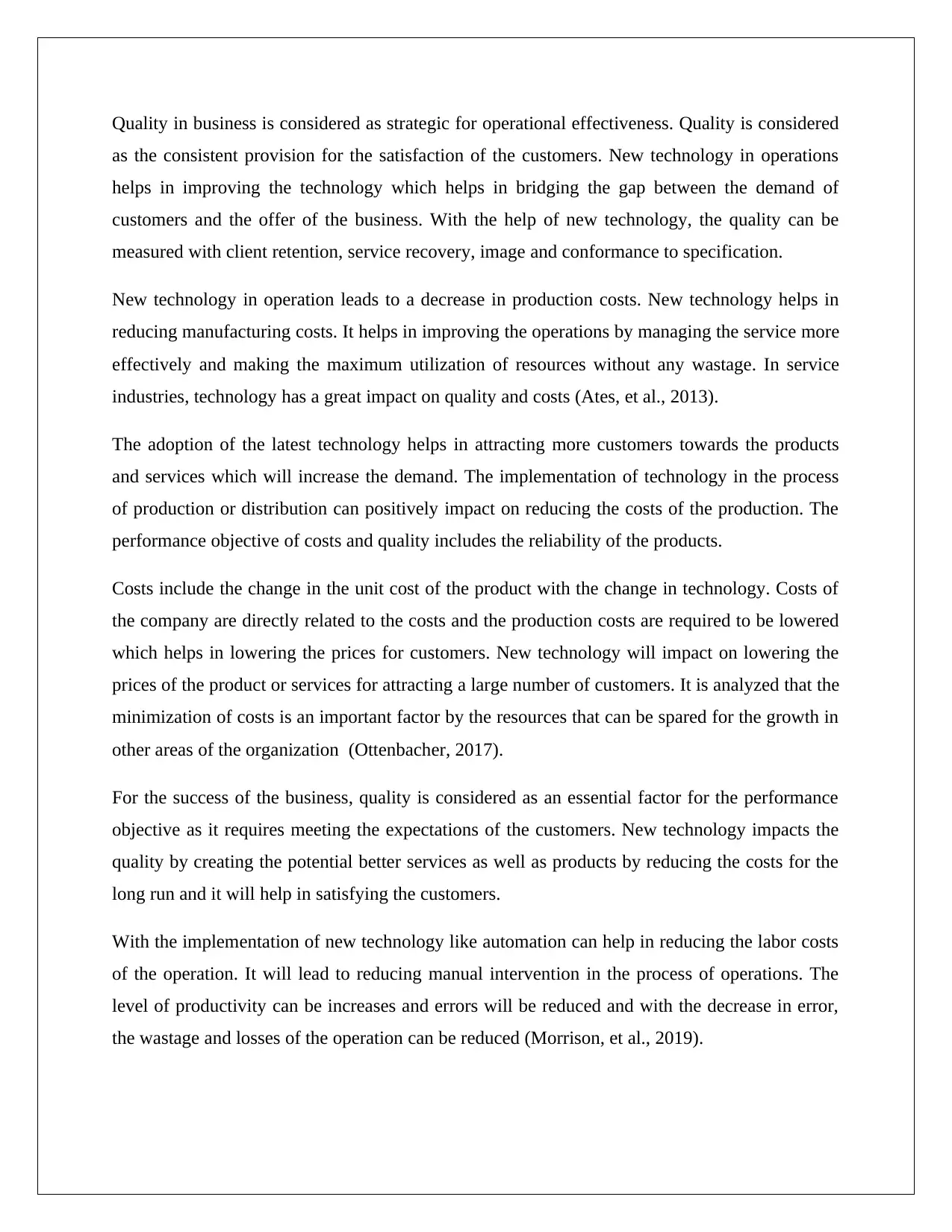
Quality in business is considered as strategic for operational effectiveness. Quality is considered
as the consistent provision for the satisfaction of the customers. New technology in operations
helps in improving the technology which helps in bridging the gap between the demand of
customers and the offer of the business. With the help of new technology, the quality can be
measured with client retention, service recovery, image and conformance to specification.
New technology in operation leads to a decrease in production costs. New technology helps in
reducing manufacturing costs. It helps in improving the operations by managing the service more
effectively and making the maximum utilization of resources without any wastage. In service
industries, technology has a great impact on quality and costs (Ates, et al., 2013).
The adoption of the latest technology helps in attracting more customers towards the products
and services which will increase the demand. The implementation of technology in the process
of production or distribution can positively impact on reducing the costs of the production. The
performance objective of costs and quality includes the reliability of the products.
Costs include the change in the unit cost of the product with the change in technology. Costs of
the company are directly related to the costs and the production costs are required to be lowered
which helps in lowering the prices for customers. New technology will impact on lowering the
prices of the product or services for attracting a large number of customers. It is analyzed that the
minimization of costs is an important factor by the resources that can be spared for the growth in
other areas of the organization (Ottenbacher, 2017).
For the success of the business, quality is considered as an essential factor for the performance
objective as it requires meeting the expectations of the customers. New technology impacts the
quality by creating the potential better services as well as products by reducing the costs for the
long run and it will help in satisfying the customers.
With the implementation of new technology like automation can help in reducing the labor costs
of the operation. It will lead to reducing manual intervention in the process of operations. The
level of productivity can be increases and errors will be reduced and with the decrease in error,
the wastage and losses of the operation can be reduced (Morrison, et al., 2019).
as the consistent provision for the satisfaction of the customers. New technology in operations
helps in improving the technology which helps in bridging the gap between the demand of
customers and the offer of the business. With the help of new technology, the quality can be
measured with client retention, service recovery, image and conformance to specification.
New technology in operation leads to a decrease in production costs. New technology helps in
reducing manufacturing costs. It helps in improving the operations by managing the service more
effectively and making the maximum utilization of resources without any wastage. In service
industries, technology has a great impact on quality and costs (Ates, et al., 2013).
The adoption of the latest technology helps in attracting more customers towards the products
and services which will increase the demand. The implementation of technology in the process
of production or distribution can positively impact on reducing the costs of the production. The
performance objective of costs and quality includes the reliability of the products.
Costs include the change in the unit cost of the product with the change in technology. Costs of
the company are directly related to the costs and the production costs are required to be lowered
which helps in lowering the prices for customers. New technology will impact on lowering the
prices of the product or services for attracting a large number of customers. It is analyzed that the
minimization of costs is an important factor by the resources that can be spared for the growth in
other areas of the organization (Ottenbacher, 2017).
For the success of the business, quality is considered as an essential factor for the performance
objective as it requires meeting the expectations of the customers. New technology impacts the
quality by creating the potential better services as well as products by reducing the costs for the
long run and it will help in satisfying the customers.
With the implementation of new technology like automation can help in reducing the labor costs
of the operation. It will lead to reducing manual intervention in the process of operations. The
level of productivity can be increases and errors will be reduced and with the decrease in error,
the wastage and losses of the operation can be reduced (Morrison, et al., 2019).
⊘ This is a preview!⊘
Do you want full access?
Subscribe today to unlock all pages.

Trusted by 1+ million students worldwide
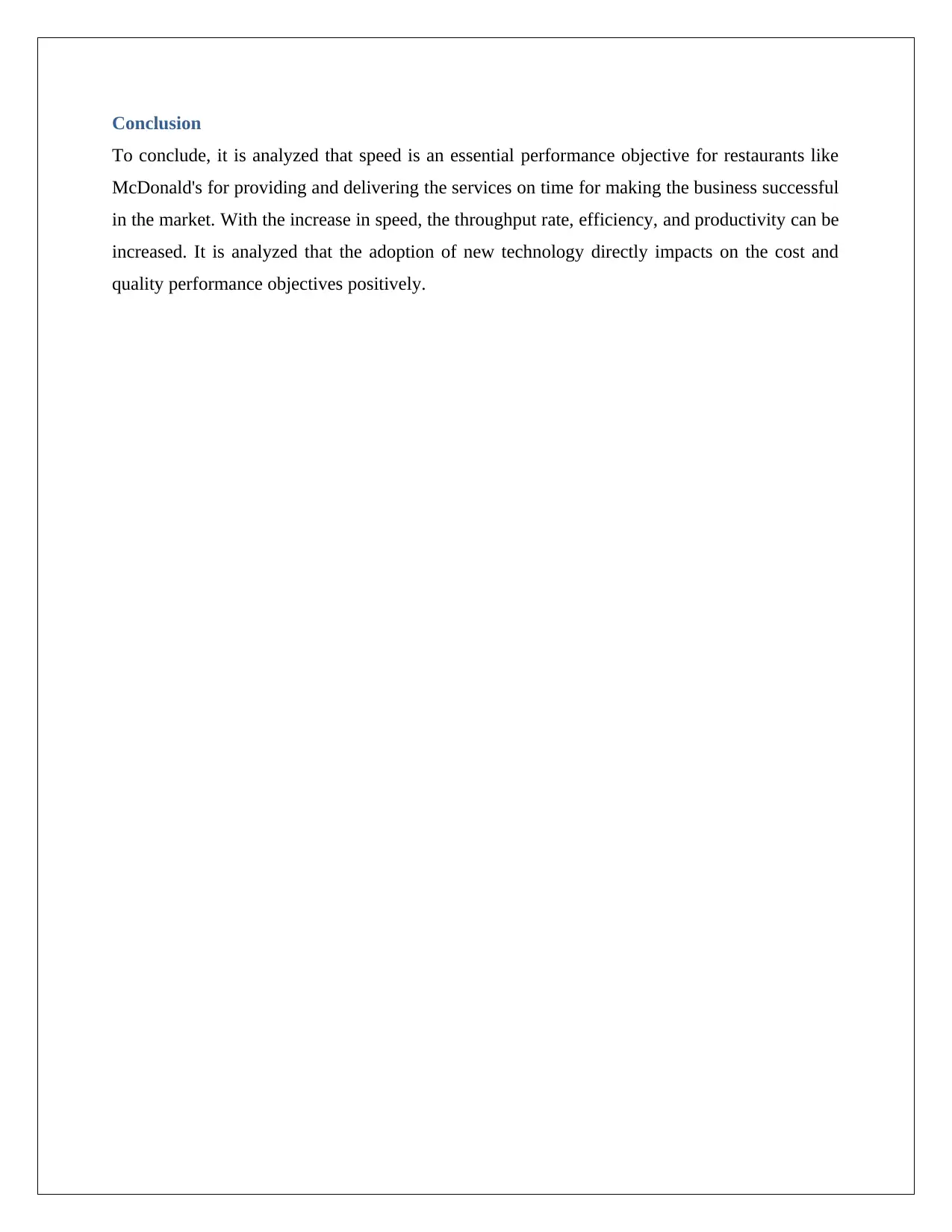
Conclusion
To conclude, it is analyzed that speed is an essential performance objective for restaurants like
McDonald's for providing and delivering the services on time for making the business successful
in the market. With the increase in speed, the throughput rate, efficiency, and productivity can be
increased. It is analyzed that the adoption of new technology directly impacts on the cost and
quality performance objectives positively.
To conclude, it is analyzed that speed is an essential performance objective for restaurants like
McDonald's for providing and delivering the services on time for making the business successful
in the market. With the increase in speed, the throughput rate, efficiency, and productivity can be
increased. It is analyzed that the adoption of new technology directly impacts on the cost and
quality performance objectives positively.
Paraphrase This Document
Need a fresh take? Get an instant paraphrase of this document with our AI Paraphraser
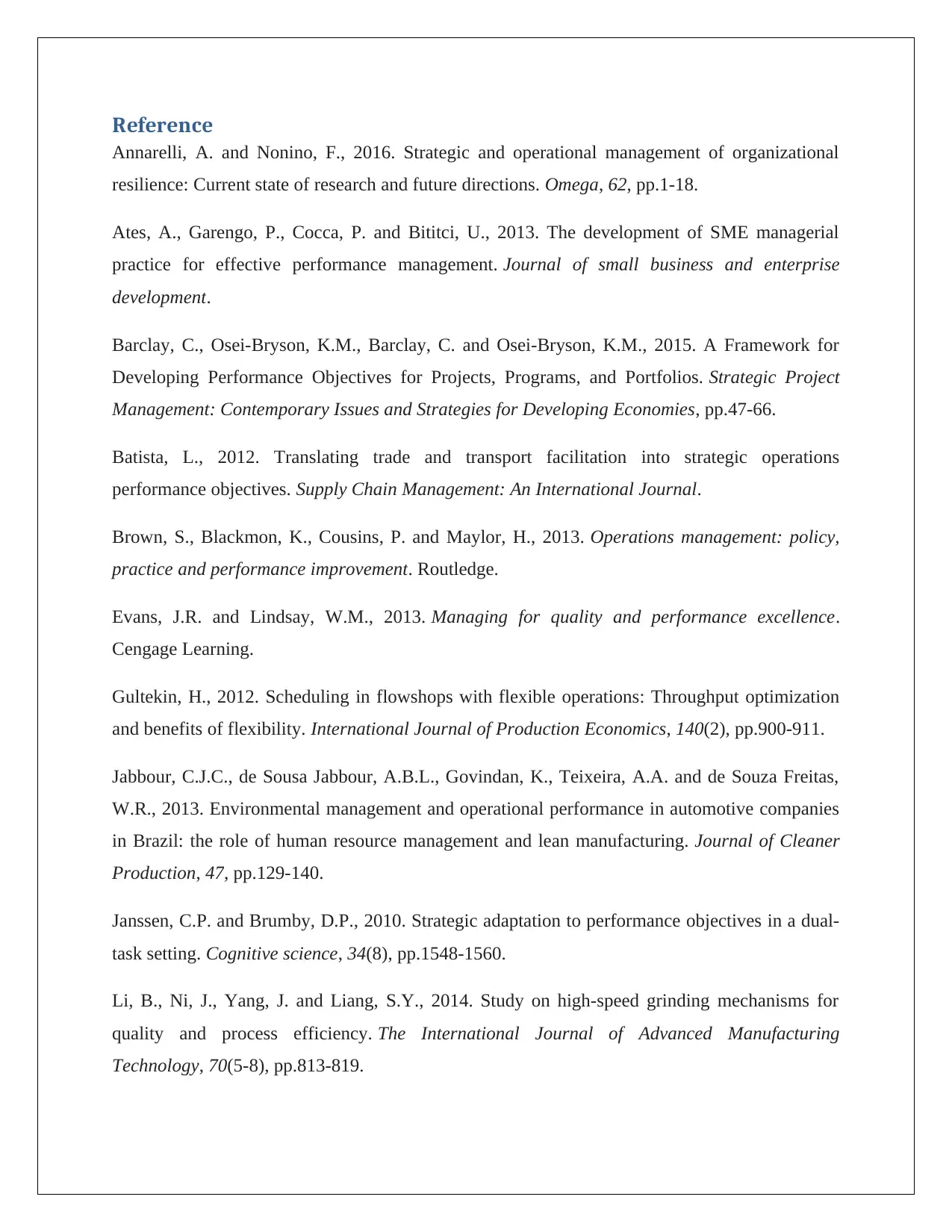
Reference
Annarelli, A. and Nonino, F., 2016. Strategic and operational management of organizational
resilience: Current state of research and future directions. Omega, 62, pp.1-18.
Ates, A., Garengo, P., Cocca, P. and Bititci, U., 2013. The development of SME managerial
practice for effective performance management. Journal of small business and enterprise
development.
Barclay, C., Osei-Bryson, K.M., Barclay, C. and Osei-Bryson, K.M., 2015. A Framework for
Developing Performance Objectives for Projects, Programs, and Portfolios. Strategic Project
Management: Contemporary Issues and Strategies for Developing Economies, pp.47-66.
Batista, L., 2012. Translating trade and transport facilitation into strategic operations
performance objectives. Supply Chain Management: An International Journal.
Brown, S., Blackmon, K., Cousins, P. and Maylor, H., 2013. Operations management: policy,
practice and performance improvement. Routledge.
Evans, J.R. and Lindsay, W.M., 2013. Managing for quality and performance excellence.
Cengage Learning.
Gultekin, H., 2012. Scheduling in flowshops with flexible operations: Throughput optimization
and benefits of flexibility. International Journal of Production Economics, 140(2), pp.900-911.
Jabbour, C.J.C., de Sousa Jabbour, A.B.L., Govindan, K., Teixeira, A.A. and de Souza Freitas,
W.R., 2013. Environmental management and operational performance in automotive companies
in Brazil: the role of human resource management and lean manufacturing. Journal of Cleaner
Production, 47, pp.129-140.
Janssen, C.P. and Brumby, D.P., 2010. Strategic adaptation to performance objectives in a dual‐
task setting. Cognitive science, 34(8), pp.1548-1560.
Li, B., Ni, J., Yang, J. and Liang, S.Y., 2014. Study on high-speed grinding mechanisms for
quality and process efficiency. The International Journal of Advanced Manufacturing
Technology, 70(5-8), pp.813-819.
Annarelli, A. and Nonino, F., 2016. Strategic and operational management of organizational
resilience: Current state of research and future directions. Omega, 62, pp.1-18.
Ates, A., Garengo, P., Cocca, P. and Bititci, U., 2013. The development of SME managerial
practice for effective performance management. Journal of small business and enterprise
development.
Barclay, C., Osei-Bryson, K.M., Barclay, C. and Osei-Bryson, K.M., 2015. A Framework for
Developing Performance Objectives for Projects, Programs, and Portfolios. Strategic Project
Management: Contemporary Issues and Strategies for Developing Economies, pp.47-66.
Batista, L., 2012. Translating trade and transport facilitation into strategic operations
performance objectives. Supply Chain Management: An International Journal.
Brown, S., Blackmon, K., Cousins, P. and Maylor, H., 2013. Operations management: policy,
practice and performance improvement. Routledge.
Evans, J.R. and Lindsay, W.M., 2013. Managing for quality and performance excellence.
Cengage Learning.
Gultekin, H., 2012. Scheduling in flowshops with flexible operations: Throughput optimization
and benefits of flexibility. International Journal of Production Economics, 140(2), pp.900-911.
Jabbour, C.J.C., de Sousa Jabbour, A.B.L., Govindan, K., Teixeira, A.A. and de Souza Freitas,
W.R., 2013. Environmental management and operational performance in automotive companies
in Brazil: the role of human resource management and lean manufacturing. Journal of Cleaner
Production, 47, pp.129-140.
Janssen, C.P. and Brumby, D.P., 2010. Strategic adaptation to performance objectives in a dual‐
task setting. Cognitive science, 34(8), pp.1548-1560.
Li, B., Ni, J., Yang, J. and Liang, S.Y., 2014. Study on high-speed grinding mechanisms for
quality and process efficiency. The International Journal of Advanced Manufacturing
Technology, 70(5-8), pp.813-819.
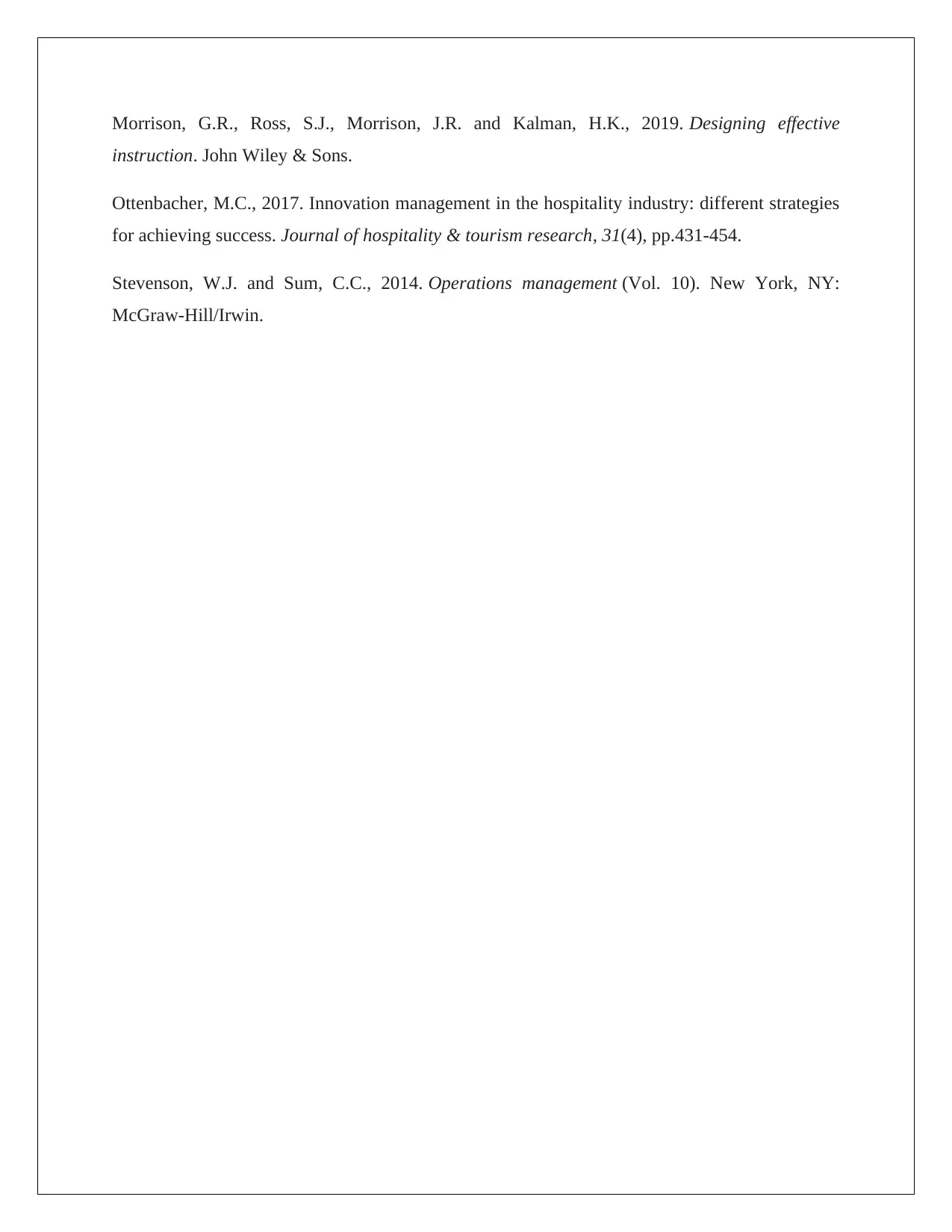
Morrison, G.R., Ross, S.J., Morrison, J.R. and Kalman, H.K., 2019. Designing effective
instruction. John Wiley & Sons.
Ottenbacher, M.C., 2017. Innovation management in the hospitality industry: different strategies
for achieving success. Journal of hospitality & tourism research, 31(4), pp.431-454.
Stevenson, W.J. and Sum, C.C., 2014. Operations management (Vol. 10). New York, NY:
McGraw-Hill/Irwin.
instruction. John Wiley & Sons.
Ottenbacher, M.C., 2017. Innovation management in the hospitality industry: different strategies
for achieving success. Journal of hospitality & tourism research, 31(4), pp.431-454.
Stevenson, W.J. and Sum, C.C., 2014. Operations management (Vol. 10). New York, NY:
McGraw-Hill/Irwin.
⊘ This is a preview!⊘
Do you want full access?
Subscribe today to unlock all pages.

Trusted by 1+ million students worldwide
1 out of 9
Related Documents
Your All-in-One AI-Powered Toolkit for Academic Success.
+13062052269
info@desklib.com
Available 24*7 on WhatsApp / Email
![[object Object]](/_next/static/media/star-bottom.7253800d.svg)
Unlock your academic potential
Copyright © 2020–2025 A2Z Services. All Rights Reserved. Developed and managed by ZUCOL.





